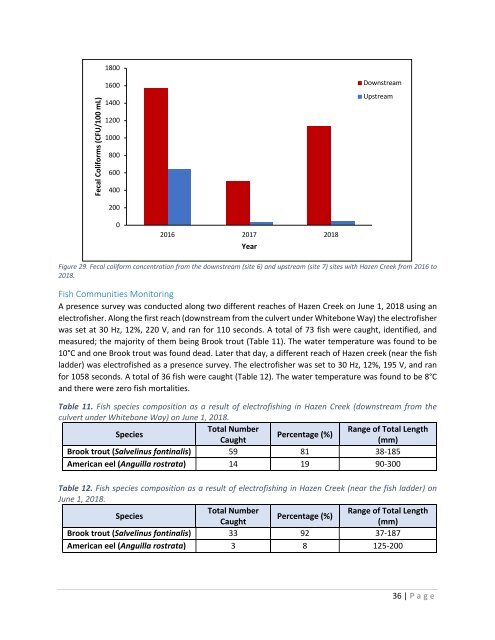Rebirth of Water 2018-2019
Continued water quality monitoring throughout the City of Saint John and the Greater Saint John area helps to gain insight into the aquatic habitats that these watercourses provide, as well as their safety for recreational use for humans. The watercourses that have had continuous monitoring this year include: Marsh Creek, Inner Harbour, Newman’s Brook, Caledonia Brook, Alder Brook, Hazen Creek, Taylor Brook, Salmon Creek and Mispec River. Additional sampling sites were added this year on the west side of the City, which include Mill Creek, Spruce Lake Stream, Walker Creek, Mosquito Cove, Manawagonish Creek, and Dominion Park. These new locations were added this year to more accurately portray the water quality of the city’s waterways as a whole. Overall, the watercourses included in this year’s sampling all continue to have the capability to provide sufficient aquatic habitats for various forms of aquatic life. There are several factors that potentially affect the water courses such as stormwater runoff, sanitary sewer overflows and riparian degradation. The stormwater runoff and riparian degradation as well as the hot, dry weather led to elevated temperatures and slightly decreased dissolved oxygen levels as compared to previous years. On average, most sites this year saw an increase in orthophosphate concentration when compared to previous data. At this time, there is no official guideline or recommendation for orthophosphate levels in place. The considerable improvements of water quality parameters for aquatic life seen in Marsh Creek since the completion of Harbour Cleanup in 2014 solidifies that the funding and resources put into the project were much needed. The most notable difference in the water quality is the dissolved oxygen concentrations, although lower in 2018 than 2017, they are still above the Canadian Council of Ministers of the Environment guideline recommended concentration of 6.5 mg/L on average at all the sites sampled.
Continued water quality monitoring throughout the City of Saint John and the Greater Saint John area helps to gain insight into the aquatic habitats that these watercourses provide, as well as their safety for recreational use for humans. The watercourses that have had continuous monitoring this year include: Marsh Creek, Inner Harbour, Newman’s Brook, Caledonia Brook, Alder Brook, Hazen Creek, Taylor Brook, Salmon Creek and Mispec River. Additional sampling sites were added this year on the west side of the City, which include Mill Creek, Spruce Lake Stream, Walker Creek, Mosquito Cove, Manawagonish Creek, and Dominion Park. These new locations were added this year to more accurately portray the water quality of the city’s waterways as a whole.
Overall, the watercourses included in this year’s sampling all continue to have the capability to provide sufficient aquatic habitats for various forms of aquatic life. There are several factors that potentially affect the water courses such as stormwater runoff, sanitary sewer overflows and riparian degradation. The stormwater runoff and riparian degradation as well as the hot, dry weather led to elevated temperatures and slightly decreased dissolved oxygen levels as compared to previous years. On average, most sites this year saw an increase in orthophosphate concentration when compared to previous data. At this time, there is no official guideline or recommendation for orthophosphate levels in place.
The considerable improvements of water quality parameters for aquatic life seen in Marsh Creek since the completion of Harbour Cleanup in 2014 solidifies that the funding and resources put into the project were much needed. The most notable difference in the water quality is the dissolved oxygen concentrations, although lower in 2018 than 2017, they are still above the Canadian Council of Ministers of the Environment guideline recommended concentration of 6.5 mg/L on average at all the sites sampled.
Create successful ePaper yourself
Turn your PDF publications into a flip-book with our unique Google optimized e-Paper software.
1800<br />
Fecal Coliforms (CFU/100 mL)<br />
1600<br />
1400<br />
1200<br />
1000<br />
800<br />
600<br />
400<br />
Downstream<br />
Upstream<br />
200<br />
0<br />
2016 2017 <strong>2018</strong><br />
Year<br />
Figure 29. Fecal coliform concentration from the downstream (site 6) and upstream (site 7) sites with Hazen Creek from 2016 to<br />
<strong>2018</strong>.<br />
Fish Communities Monitoring<br />
A presence survey was conducted along two different reaches <strong>of</strong> Hazen Creek on June 1, <strong>2018</strong> using an<br />
electr<strong>of</strong>isher. Along the first reach (downstream from the culvert under Whitebone Way) the electr<strong>of</strong>isher<br />
was set at 30 Hz, 12%, 220 V, and ran for 110 seconds. A total <strong>of</strong> 73 fish were caught, identified, and<br />
measured; the majority <strong>of</strong> them being Brook trout (Table 11). The water temperature was found to be<br />
10°C and one Brook trout was found dead. Later that day, a different reach <strong>of</strong> Hazen creek (near the fish<br />
ladder) was electr<strong>of</strong>ished as a presence survey. The electr<strong>of</strong>isher was set to 30 Hz, 12%, 195 V, and ran<br />
for 1058 seconds. A total <strong>of</strong> 36 fish were caught (Table 12). The water temperature was found to be 8°C<br />
and there were zero fish mortalities.<br />
Table 11. Fish species composition as a result <strong>of</strong> electr<strong>of</strong>ishing in Hazen Creek (downstream from the<br />
culvert under Whitebone Way) on June 1, <strong>2018</strong>.<br />
Species<br />
Total Number<br />
Range <strong>of</strong> Total Length<br />
Percentage (%)<br />
Caught<br />
(mm)<br />
Brook trout (Salvelinus fontinalis) 59 81 38-185<br />
American eel (Anguilla rostrata) 14 19 90-300<br />
Table 12. Fish species composition as a result <strong>of</strong> electr<strong>of</strong>ishing in Hazen Creek (near the fish ladder) on<br />
June 1, <strong>2018</strong>.<br />
Species<br />
Total Number<br />
Range <strong>of</strong> Total Length<br />
Percentage (%)<br />
Caught<br />
(mm)<br />
Brook trout (Salvelinus fontinalis) 33 92 37-187<br />
American eel (Anguilla rostrata) 3 8 125-200<br />
36 | P age

















